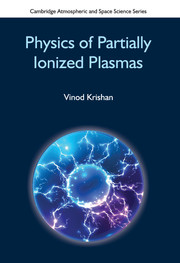Book contents
- Frontmatter
- Dedication
- Contents
- Figures
- Preface
- 1 Partially Ionized Plasmas Here and Everywhere
- 2 Multiflkuid Description of Partially Ionized Plasmas
- 3 Equilibrium of Partially Ionized Plasmas
- 4 Waves in Partially Ionized Plasmas
- 5 Advanced Topics in Partially Ionized Plasmas
- 6 Research Problems in Partially Ionized Plasmas
- Supplementary Matter
- Index
6 - Research Problems in Partially Ionized Plasmas
Published online by Cambridge University Press: 13 September 2017
- Frontmatter
- Dedication
- Contents
- Figures
- Preface
- 1 Partially Ionized Plasmas Here and Everywhere
- 2 Multiflkuid Description of Partially Ionized Plasmas
- 3 Equilibrium of Partially Ionized Plasmas
- 4 Waves in Partially Ionized Plasmas
- 5 Advanced Topics in Partially Ionized Plasmas
- 6 Research Problems in Partially Ionized Plasmas
- Supplementary Matter
- Index
Summary
Partially ionized plasmas have only recently started getting attention as a research topic especially in the context of cosmic objects and environs. More often than not, the neutral particles have been treated as collision partners for the dominant charged components of a plasma. Alternately, there are cases where the neutrals are the dominant component, and therefore they become the main source of inertia in a partially ionized plasma. There is a lot to investigate in the intermediate circumstances. A glimpse of the three-fluid, the two-fluid, the single-fluid pictures, along with the special case of a weakly ionized plasma has been attempted in the previous chapters. The study is far from complete!
In this chapter, a few research problems, in continuation of the subject matter presented in this book are listed chapterwise. These are the research problems I myself would have liked to pursue had I enough resources at my disposal.
The Three-fluid Description The three-fluid description of a partially ionized plasma has been given in Section 2:3 where it was assumed that the plasma consisted of electrons, ions with fixed electric charge Ze and neutrals. It is however, possible, in such a system, that some of the neutrals pick up electric charges due to electron attachment, charge exchange, ionization or acquire an electric dipole moment due to polarization depending upon the temperature of the plasma. The charging of the neutrals is akin to the charging of the dust grains in a dusty plasma and should be included in the set of Eqs (2.119)–(2.134) along with the assurance of the electric charge conservation. Some efforts in this direction have been made, for example, in the context of the stability of cold solar prominence material high up in the atmosphere against the solar gravity.
The Two-fluid Description
The electron fluid and the ion fluids were combined to construct the magnetohydrodynamic (MHD) fluid in Subsection 2.4.1. The MHD fluid and the neutral fluid then form the two-fluid description of a partially ionized plasma.
- Type
- Chapter
- Information
- Physics of Partially Ionized Plasmas , pp. 244 - 248Publisher: Cambridge University PressPrint publication year: 2016

